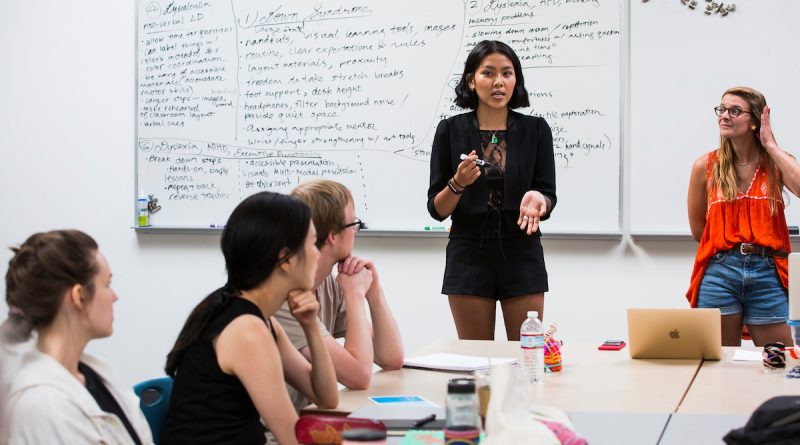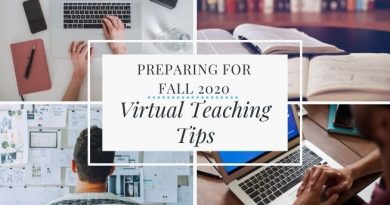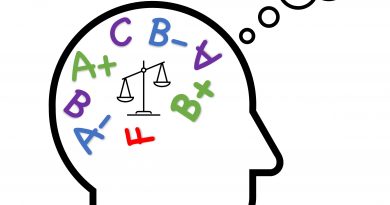Setting the Stage for a Successful Semester
One of the best things a professor can do is get to know your students for who they are. And allow them to do the same for you.
by Kayla Elliott, A23, Child Study & Human Development/Education, Student Ambassador Pedagogical Partnership Program (P3)
The relationship between faculty and college students is one of the most important and impactful relationships a student will have. Students define their relationships with faculty in many different ways, but a key component of this relationship relies on one question: how well do I know my professor? The answer may vary across students, but many students would respond and say, “I don’t really know my professor.” A big reason for this is the way that the pandemic has upended the ways we learn, interact, and form relationships – especially in education.
We have become accustomed to logging on to Zoom and looking at twenty other little boxes. But what happens when school starts shifting to a “new normal”? Academia shifting to post-pandemic learning consists of classes switching from a remote option to in person, optional masks, and social distance is no longer required. As a student, how do we relearn how to engage with one another again? As a professor, how can I motivate my students to engage with me and their peers? Setting the stage at the beginning of the semester is integral in fostering this environment.
Creating student-faculty relationships through introductions
The first step in building an impactful faculty-student relationship is professors introducing themselves thoroughly during the first class. Students deserve to know who is teaching them and this gives space for finding interests between professors and students. According to Micari, M., & Pazos, P. (2012), “the more a student feels he or she had a positive relationship with the professor – that is, looking up to the professor, feeling comfortable approaching the professor, and feeling that the professor respects the students – the higher the student’s final grade.” For example, during introductions, a professor might explain her research on the cognitive effects of trauma on adolescents in low-income communities, and a student interested in this could have a conversation with the professor about their interest in this topic. This very small yet simple introduction could open the door to building a relationship between the teacher and the student.
Another way for a faculty member to introduce themselves is creating a “Meet the Professor” brochure consisting of their name, hometown, hobbies/interests, contact information, and research interests. Creating these brochures will allow students to get to know faculty on a deeper level, rather than as an authority figure. Also, this allows for students to feel like they can connect with a professor about other things, even if it isn’t directly related to course content.
Fostering a collegial classroom environment
For the majority of courses, the first class of the semester starts with a two-minute professor introduction and then immediately delves into the course material. Coursework is important, but should the entirety of the first class be dedicated to it? The beginning of the semester is chaotic for everyone as we’re all getting back into the swing of work, school, and personal life.
At the beginning of the class, there should be an opportunity for students to introduce themselves to the professor and one another. This allows a space where students can talk about themselves as an individual rather than as a student. Try bringing a few “get to know you” questions for students to answer with one another. At the beginning of the class, most students may not know each other so this allows opportunity for conversation amongst each other. Considering that this is the first year of face-to-face instruction (without masks), it’s definitely an adjustment for faculty and students. Creating an environment where students feel safe enough to share about themselves will make it a positive learning space. Lastly, this practice will make students feel that faculty value student-student relationships just as much as course material and other components of the class.
Setting the tone for class expectations and class communication
The professor-student dynamic is influenced by multiple factors, but the first few interactions between the two can shape their feelings toward one another. A study about the effects of first impressions on course evaluations found “…good first impressions do, in fact, increase teacher evaluation ratings for different instructors” (Samudra, P. G., Min, I., Cortina, K. S., & Miller, K. F., 2016). In all realms of life first impressions are important, but in academia they can dictate if there will be a positive relationship between faculty and students.
One way to set the tone is to take time to ensure that all students are on the same page about the course syllabus and expectations, rather than rushing into course content. To ensure students fully understand course expectations, professors should reiterate them during the first class. For a small class or large lecture class, this could look like setting aside 15 minutes to go over the syllabus and answer questions about it. Setting the tone is communicating course requirements and making expectations clear from the start. At the beginning of the semester, students are still making schedule changes so having a class where they completely understand what is expected of them is important. When planning your first class of the semester ask yourself what type of environment you want to create. Then align your planning with the vision you have for your course.
Bringing your authentic version of yourself into the classroom
Students struggle with seeing the “other” side of faculty, meaning the “human” side, rather than the professor side. Contrary to popular belief, professors do not have to be serious all the time. While it is important for there to be mutual respect between teachers and students, bringing humor into the classroom can minimize the nervousness that everyone is feeling. It is possible to learn and have fun at the same time and this is a great way to create rapport between students and teachers. Gilliand & Mauritsen (1971) explain that “…teachers need to become aware of the impact that humor can have on a [student’s] personality; the aid it can give in providing a relaxed and enjoyable classroom atmosphere; the humanizing effect it can have.” The classroom often has a serious atmosphere as is, but adding in a few jokes here and there can ease that tension.
If you are less comfortable leveraging humor, bringing in your human self can also signal authenticity. For example, you could share a bit about your own hobbies, or allow students to share a highlight from their weekend with a partner. This could take about three minutes and will allow students to get to know each other. This allows students to see a more authentic version of faculty.
the more a student feels he or she had a positive relationship with the professor – that is, looking up to the professor, feeling comfortable approaching the professor, and feeling that the professor respects the students – the higher the student’s final grade.
Micari, M., & Pazos, P. (2012)
The beginning of the school year can be hectic and it’s easy to worry about the nitty-gritty details of the classroom. These are important, but one of the best things a professor can do is get to know your students for who they are. And allow them to do the same for you. Creating this rapport from the beginning can create amazing relationships between faculty and students. Many people focus on “finishing strong,” but starting strong is just as important.
References
Gilliland, H., & Mauritsen, H. (1971). Humor in the Classroom. The Reading Teacher, 24(8), 753–761. http://www.jstor.org/stable/20196594
Micari, M., & Pazos, P. (2012). Connecting to the Professor: Impact of the Student—Faculty Relationship in a Highly Challenging Course. College Teaching, 60(2), 41–47. http://www.jstor.org/stable/23240339
Samudra, P. G., Min, I., Cortina, K. S., & Miller, K. F. (2016). No Second Chance to Make a First Impression: The “Thin-Slice” Effect on Instructor Ratings and Learning Outcomes in Higher Education. Journal of Educational Measurement, 53(3), 313–331. http://www.jstor.org/stable/43940622
See Also
Inclusive Teaching Tips (Big and Small!) From P3’s Student Partners




